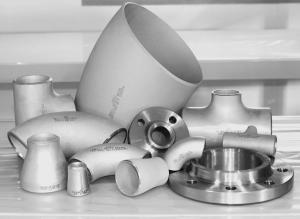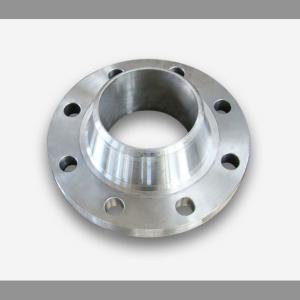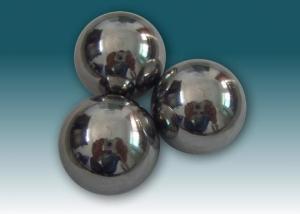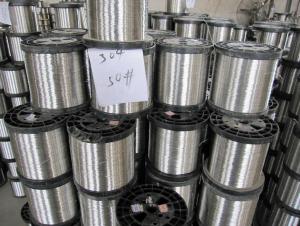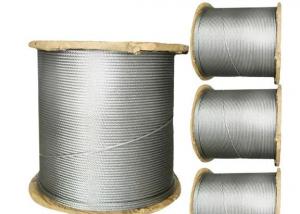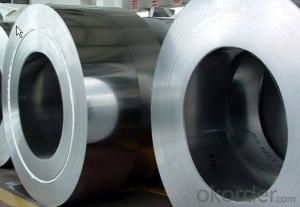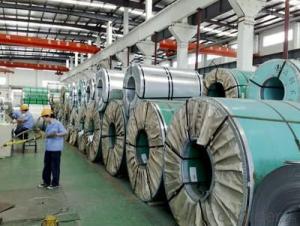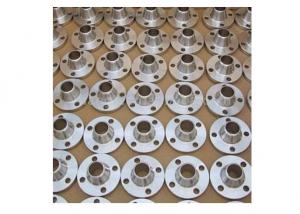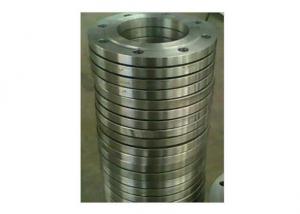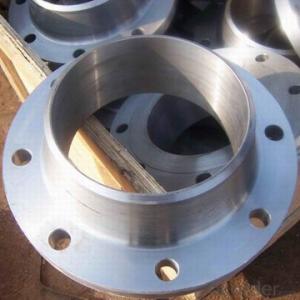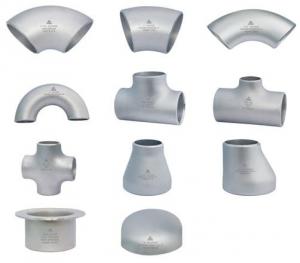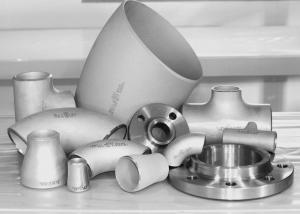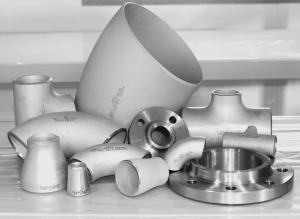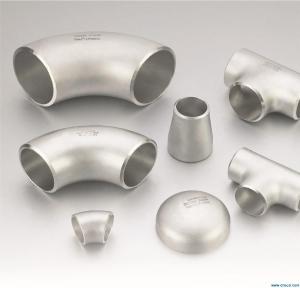Stainless Steel Slip-on Welding Flanges
- Loading Port:
- China Main Port
- Payment Terms:
- TT or LC
- Min Order Qty:
- 5 Pieces pc
- Supply Capability:
- 10000 Pieces Per Month pc/month
OKorder Service Pledge
OKorder Financial Service
You Might Also Like
Stainless Steel Fittings
Specifications Features:
1) Carbon steel fitting and stainless steel fitting
2) Standard: ASME, ANSI, API, JIS
1. BUTT WELDED FITTING:
2. Production acc. to the standard of GB /ASTM / ASME / DIN / JIS
ASTM B 16.9 /16.11 B 16.28 JIS B 2311/2220 DIN2617/2616/2615/2391
3. Types: Elbows, seamless and welded, LR & SR ,Bend -Equal and reducing Tees,
seamless and welded - Concentric and eccentric Reducers,seamless and welded -Caps
4. Wall thickness: From Sch5 up to Sch160/STD/XS/XXS
5. Material Grades: A403,WP304, WP304L, Wp316, WP316L, A234WPB
6. Dimensions: Seamless: from 1/2' up to 24'
7. size: From 1/2" up to 72"
Outer packing:Seaworthy plywood case
|
Grade |
TP304,TP304L,TP321,TP316L,TP310S etc. |
|
connection |
welding |
|
techniques |
forged |
|
Surface finishing |
180/240/320/400 grit |

- Q: Are stainless steel flats suitable for high-pressure applications?
- Yes, stainless steel flats are suitable for high-pressure applications. Stainless steel is known for its high strength and corrosion resistance, making it ideal for environments with high pressure and potential exposure to harsh conditions. Additionally, stainless steel flats can withstand high temperatures and maintain their structural integrity, further enhancing their suitability for high-pressure applications.
- Q: Are stainless steel flats suitable for automotive applications?
- Indeed, automotive applications can benefit from the use of stainless steel flats. Renowned for its exceptional strength, durability, and corrosion resistance, stainless steel proves to be an ideal material for a variety of automotive components. Body panels, trim, exhaust systems, brackets, and fasteners are just a few examples of automotive applications where stainless steel flats can be effectively employed. By providing excellent structural integrity, withstanding harsh environmental conditions, and preserving their appearance over time, stainless steel flats guarantee reliability and longevity in the demanding automotive industry. Moreover, due to its high heat resistance, stainless steel is particularly suitable for automotive parts exposed to extreme temperatures. In summary, stainless steel flats possess the necessary qualities required for automotive applications, ensuring reliability and longevity in the challenging automotive sector.
- Q: How do stainless steel flats resist corrosion in alkaline environments?
- Due to its specific properties, stainless steel flats exhibit excellent resistance to corrosion in alkaline environments. The presence of chromium in the alloy composition is the primary factor that enables stainless steel flats to resist corrosion. When exposed to the atmosphere, chromium reacts with oxygen and forms a thin protective oxide layer on the surface of the stainless steel. This oxide layer acts as a barrier, effectively preventing further oxidation or corrosion of the metal beneath it. In alkaline environments, the oxide layer on stainless steel flats is particularly effective in preventing corrosion. Alkaline solutions, characterized by their high pH level and low concentration of hydrogen ions, help maintain the stability of the oxide layer. These solutions lack aggressive ions or acidic components that could potentially attack the stainless steel surface. Moreover, stainless steel flats often contain other alloying elements, like molybdenum, which further enhance their corrosion resistance in alkaline environments. Molybdenum increases the material's resistance to pitting and crevice corrosion, common forms of localized corrosion that can occur in alkaline conditions. Overall, the combination of chromium and other alloying elements in stainless steel flats provides a robust defense against corrosion in alkaline environments. These flats are an excellent choice for applications requiring durability and resistance to corrosion in alkaline conditions, such as chemical processing plants, food and beverage industries, and wastewater treatment facilities.
- Q: How is stainless steel flat different from other steel products?
- Stainless steel flat differs from other steel products primarily due to its composition and properties. Unlike regular steel, stainless steel contains a higher percentage of chromium, which forms a protective layer on its surface, making it resistant to corrosion and rust. This makes stainless steel flat highly durable and suitable for applications in environments where exposure to moisture or chemicals is common. Additionally, stainless steel flat offers excellent strength, heat resistance, and a polished appearance, making it a preferred choice in various industries such as construction, automotive, and food processing.
- Q: What are the different types of stainless steel flats used in the chemical industry?
- The different types of stainless steel flats commonly used in the chemical industry include austenitic stainless steel flats (such as grades 304 and 316), ferritic stainless steel flats (such as grade 430), and duplex stainless steel flats (such as grade 2205). Each type has its own unique properties and advantages, making them suitable for various applications in the chemical industry.
- Q: Can stainless steel flats be used in the aerospace aftermarket?
- Yes, stainless steel flats can be used in the aerospace aftermarket. Stainless steel is known for its corrosion resistance, high strength, and durability, making it a suitable material for various aerospace applications. It is commonly used in aircraft structures, engine components, and other critical parts in the aerospace industry. Stainless steel flats can be used for manufacturing or repairing aerospace equipment and are often preferred for their excellent mechanical properties and resistance to harsh environmental conditions.
- Q: Are stainless steel flats suitable for outdoor sculptures?
- Yes, stainless steel flats are highly suitable for outdoor sculptures. Stainless steel is a popular choice for outdoor sculptures due to its durability and resistance to corrosion. It is able to withstand various weather conditions, including rain, snow, and sunlight, without deteriorating or losing its structural integrity. This makes it ideal for outdoor sculptures that are exposed to the elements and need to withstand the test of time. Additionally, stainless steel flats offer a sleek and modern aesthetic, adding a touch of elegance to any outdoor space. Its versatility allows for various artistic designs and shapes to be created, making it a popular choice among sculptors. Overall, stainless steel flats are an excellent choice for outdoor sculptures due to their durability, resistance to corrosion, and aesthetic appeal.
- Q: How is stainless steel flat made?
- Stainless steel flat is typically made through a process called hot rolling, which involves heating the steel billet or slab to a high temperature and then passing it between a series of rollers to reduce its thickness and shape it into a flat form. The first step in the process is melting the raw materials, which include iron ore, chromium, nickel, and other alloying elements, in an electric furnace. Once the molten steel is formed, it is cast into large slabs or billets. These slabs are then reheated to a specific temperature to soften the steel and make it more malleable. The next stage is hot rolling, where the reheated slabs are passed through a series of rolling mills. In this process, the slabs are gradually reduced in thickness by repeatedly passing them through rollers that exert high pressure. As the steel passes through each roll, it is shaped and stretched, resulting in a thinner and more uniform flat shape. The rollers can have different configurations, such as flat, grooved, or contoured, to achieve the desired dimensions and surface finish. During the rolling process, the steel is often cooled using water or air to prevent overheating and ensure the proper mechanical properties. Furthermore, the steel may undergo annealing, a heat treatment process that involves heating and slowly cooling the material to improve its strength and remove any internal stresses. After the hot rolling process, the stainless steel flat may undergo additional cold rolling or finishing processes to achieve the desired thickness, surface smoothness, and dimensional accuracy. These processes may include further rolling, pickling (removal of impurities), annealing, and descaling. Finally, the stainless steel flat is cut to the required length, inspected for quality, and packaged for distribution or further processing. Overall, the production of stainless steel flat involves a combination of high-temperature melting, hot rolling, and various finishing processes to ensure its durability, corrosion resistance, and aesthetic appeal.
- Q: Can stainless steel flats be an alternative to carbon steel flats?
- Stainless steel flats have the potential to serve as a viable substitute for carbon steel flats in specific situations. In comparison to carbon steel, stainless steel possesses numerous advantages, such as superior resistance to corrosion, ability to withstand high temperatures, and favorable mechanical properties. These attributes render stainless steel flats suitable for settings where concerns regarding corrosion or oxidation arise, such as in the marine industry or within chemical processing plants. Furthermore, stainless steel flats are renowned for their visually appealing appearance and impeccable surface finish, making them highly sought-after for architectural and decorative purposes. Additionally, they exhibit exceptional durability and necessitate minimal upkeep, which ultimately reduces long-term expenses. Nevertheless, it is crucial to acknowledge that stainless steel flats generally incur higher costs compared to carbon steel flats. Consequently, the selection between these two materials frequently hinges upon the specific demands of the application, encompassing budgetary limitations, desired performance characteristics, and environmental elements.
- Q: How do I calculate the moment of inertia for a stainless steel flat?
- To calculate the moment of inertia for a stainless steel flat, you would need to know the dimensions of the flat, such as its length, width, and thickness. The moment of inertia can be calculated using the formula specific to the shape of the object, such as a rectangular plate. For a rectangular plate, the moment of inertia can be calculated as (1/12) x (length) x (width)^3.
1. Manufacturer Overview
| Location | Anhui,China |
| Year Established | 2003 |
| Annual Output Value | Above US$16 Million |
| Main Markets | South Korea;Japan; Europe;ASEAN;India |
| Company Certifications | ISO 9001:2000; |
2. Manufacturer Certificates
| a) Certification Name | |
| Range | |
| Reference | |
| Validity Period |
3. Manufacturer Capability
| a) Trade Capacity | |
| Nearest Port | Shanghai |
| Export Percentage | 70% |
| No.of Employees in Trade Department | 160 People |
| Language Spoken: | English;Chinese;Japanese;Korea |
| b) Factory Information | |
| Factory Size: | Above 300,000 square meters |
| No. of Production Lines | Above 10 |
| Contract Manufacturing | OEM Service Offered;Design Service Offered |
| Product Price Range | Average |
Send your message to us
Stainless Steel Slip-on Welding Flanges
- Loading Port:
- China Main Port
- Payment Terms:
- TT or LC
- Min Order Qty:
- 5 Pieces pc
- Supply Capability:
- 10000 Pieces Per Month pc/month
OKorder Service Pledge
OKorder Financial Service
Similar products
Hot products
Hot Searches
Related keywords
